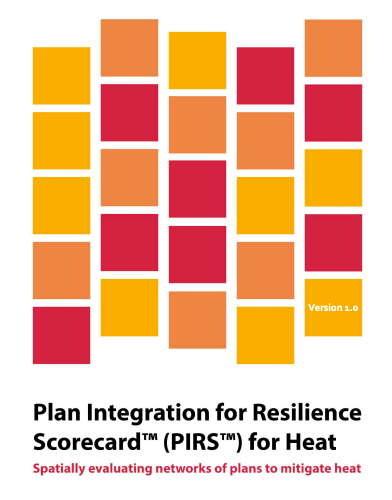Creating Cool and Resilient Communities: Integrating Plans for Urban Heat Mitigation
Published: May 30, 2023
Behind the scenes, cities and communities around the world are managed according to an often disjointed web of policies and plans.
Most of these plans guide land-use planning decisions that can help mitigate or exacerbate urban heat and its impacts on people, but more often than not they do not work together to reduce risk and maximize benefits.
A new guide developed with support from the U.S. NOAA Climate Program Office’s Extreme Heat Risk Initiative presents policy makers with how-to guidance on integrating their plans for the purpose of mitigating urban heat hazard in the built environment.

What is plan integration for urban heat mitigation?
Plan integration for urban heat mitigation involves aligning various planning strategies to tackle the challenges posed by rising temperatures and extreme heat events – maximizing synergies across hazard mitigation, disaster response, climate action and adaptation, resilience, sustainability, urban and land use planning, transportation, housing and other relevant sectors.
“Local policy makers are often siloed by department and discipline, meaning efforts to address urban heat can be uncoordinated and less effective. Integrating local plans across sectors helps ensure policies work together to advance efforts to mitigate urban heat and align with the hottest and most vulnerable communities. ” – Ladd Keith, University of Arizona
What is the Plan Integration for Resilience Scorecard™ (PIRS™) for Heat?
The Plan Integration for Resilience Scorecard™ (PIRS™) is a methodology for assessing how well a community’s network of plans addresses a hazard, originally developed for flood hazard. The new PIRS™ for Heat guide explains the rationale for the approach developed for urban heat hazard, provides a step-by-step guide for any practitioner or researcher interested in applying the methodology, includes a detailed and ready-to-go worksheet, and summarizes key plan integration findings from five communities across the U.S.
Why is plan integration essential for urban heat mitigation?
Coordinated Action: Urban heat mitigation requires collaboration among different stakeholders, including planners, policymakers, public health officials, and community members. Plan integration facilitates coordinated action by aligning goals, strategies, and policies across multiple plans, ensuring everyone is on the same page.
Heat-Sensitive Land Use: Integrating urban heat mitigation into land use planning allows for the identification and protection of heat-sensitive areas, such as parks, green spaces, and vulnerable neighborhoods. This approach ensures equitable access to cool spaces and reduces the urban heat island effect.
Resilient Infrastructure: Plan integration enables the incorporation of urban heat mitigationstrategies into infrastructure planning. By considering shading, green infrastructure, cool roofs, and energy-efficient design, communities can build resilient infrastructure that minimizes heat impacts and enhances livability.
What are some examples of plan integration in urban heat mitigation?
Green Infrastructure: Integrating urban heat mitigation into land use planning can promote the incorporation of green infrastructure elements like urban forests, green roofs, and permeable surfaces. These features provide shade, evaporative cooling, and improve air quality.
Transportation Planning: Plan integration for urban heat mitigation can prioritize the development of walkable and bike-friendly transportation networks. This approach encourages active transportation, reduces vehicle emissions, and provides accessible and comfortable alternatives during hot weather.
Isn’t plan integration too complex?
While plan integration does require careful coordination and collaboration, the long-term benefits outweigh the challenges. It ensures a cohesive approach to urban heat mitigation and allows for more effective use of resources and expertise.
Will plan integration limit creativity and flexibility?
On the contrary, plan integration provides a framework that encourages innovative solutions within a broader urban heat mitigation vision. It supports creative urban design, landscape architecture, and sustainable technologies that enhance community well-being. The discussion across disciplines and departments that occur through the PIRS™ for Heat approach can also lead to new connections and improved plan quality more broadly.
Addressing urban heat is a pressing challenge in our rapidly changing climate, and calls for coordinated action across sectors and disciplines. The PIRS™ for Heat guidebook serves as an invaluable resource, providing insights and best practices for incorporating urban heat mitigation strategies into planning processes.

